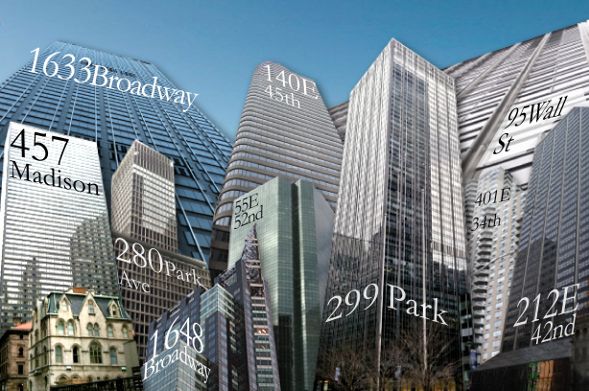This piece originally appeared in The New York World.
The strip of pavement outside 180 Water St., home to the New York City Human Resources Administration (HRA), may not look like much, but it’s for sale. The building’s owner, Melohn Properties, recently put the tower on the market for $180 million. If the owners get their asking price, this drab stretch of concrete, plus a loading area on the side of the building, will be worth nearly $21 million to them. That’s because the sidewalk is a privately owned public space, like hundreds of others around Manhattan — including Zuccotti Park, home base of Occupy Wall Street.
In exchange for this sliver of sidewalk, public records show, the developers of 180 Water St. received permission to build nearly 47,000 square feet of office space that would not have otherwise been permitted by zoning. Multiply each of those square feet by the current asking price — which we calculate at about $455 per square foot — and the value of privately owned public spaces to property owners comes into sharp focus.
The sidewalk outside 180 Water St. has special significance because it’s the site to which advocates for the poor and people with AIDS flock to protest program cuts and other actions taken by HRA. While some demonstrators report requests from police and building security to refrain from blocking or distributing flyers at the building entrance — part of the required 2,400 publicly accessible space under an overhang — they and other members of the public generally have free access.
An adjoining “public space” on narrow Pearl Street is another story. On Monday, five vehicles sat parked in the supposedly public area; two had HRA employee parking permits in their windows. (HRA was not available to comment by our deadline.) City records show complaints of parking in the space in 2000 and 2006, and dating as far back as 1982.
“If anyone’s parking there, we don’t control that,” said Barry Goldberg, general counsel for Melohn Properties.
Goldberg was the owner’s attorney on the company’s purchase of 180 Water St. in the 1990s and is now handling its sale. He says the call from The New York World was the first he had heard of the property having obligations to open the sidewalk to the public. “I’m not aware of it at all,” he said, noting that no documentation came up in the title search or other documents in the transactions. “We comply with the law as required.”

Plaza behind the HRA headquarters.
Credit: Yolanne Almanzar
Like many privately owned public spaces, 180 Water St. picked up the extra square footage “as of right,” because its developer met the standards set by the City Planning Commission.
The battle for Zuccotti Park brought unprecedented attention to privately owned public spaces, property whose developers committed to making them open to the public, in exchange for a boost in the scale of the building they could construct. But it also overshadowed a basic question: Who is getting the better end of the deal for these spaces, property owners or the public?
We decided to find out. The New York World filed a freedom of information request with the Department of City Planning to obtain records detailing the public space promises made and extra square footage received by each property developer, compiled in 2000 by the urban planner Jerold Kayden in collaboration with the department and the Municipal Art Society. In total, says Kayden, now a professor at the Harvard Graduate School of Design, such spaces have enabled the development of 20 million square feet of New York City real estate that zoning would not have otherwise permitted.
Then we looked to put a price tag on the spaces. How much did the extra square footage add to the total value of each piece of real estate? That’s easier said than done. Office lease prices are a closely guarded secret, and since market conditions change, the price a building sold for five years ago doesn’t say much about its value now.
So we turned to a list, compiled by Crain’s New York Business based on data from Real Capital Analytics, detailing New York City’s 25 biggest commercial real estate sales of 2011. Ten of those properties included privately owned public spaces. Based on the price per square foot of those deals and the amount of extra space generated through the public space bonus, we calculated that privately owned public spaces contributed anywhere between $19 million and $353 million to the value of each property.
Click here to see a slideshow of 10 pricey NYC privately owned public spaces, compiled by The New York World.
Additional reporting by Salim Essaid, Aidan Gardiner and Maral Noshad Sharifi.
















